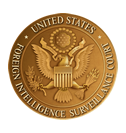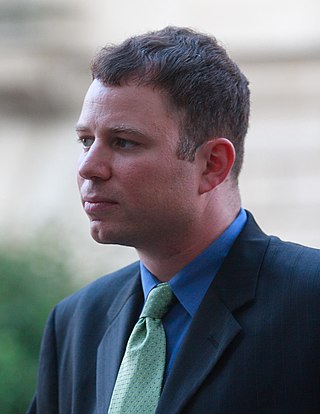Related Research Articles

The United States Foreign Intelligence Surveillance Court (FISC), also called the FISA Court, is a U.S. federal court established under the Foreign Intelligence Surveillance Act of 1978 (FISA) to oversee requests for surveillance warrants against foreign spies inside the United States by federal law enforcement and intelligence agencies.
Cryptome was an online library and 501(c)(3) private foundation created in 1996 by John Young and Deborah Natsios and closed in 2023. The site collected information about freedom of expression, privacy, cryptography, dual-use technologies, national security, intelligence, and government secrecy.

The Terrorist Surveillance Program was an electronic surveillance program implemented by the National Security Agency (NSA) of the United States in the wake of the September 11, 2001 attacks. It was part of the President's Surveillance Program, which was in turn conducted under the overall umbrella of the War on Terrorism. The NSA, a signals intelligence agency, implemented the program to intercept al Qaeda communications overseas where at least one party is not a U.S. person. In 2005, The New York Times disclosed that technical glitches resulted in some of the intercepts including communications which were "purely domestic" in nature, igniting the NSA warrantless surveillance controversy. Later works, such as James Bamford's The Shadow Factory, described how the nature of the domestic surveillance was much, much more widespread than initially disclosed. In a 2011 New Yorker article, former NSA employee Bill Binney said that his colleagues told him that the NSA had begun storing billing and phone records from "everyone in the country."
Parallel construction is a law enforcement process of building a parallel, or separate, evidentiary basis for a criminal investigation in order to conceal how an investigation actually began.

WikiLeaks is a publisher and media organisation founded in 2006. It operates as a non-profit and is funded by donations and media partnerships. It has published classified documents and other media provided by anonymous sources. It was founded by Julian Assange, an Australian editor, publisher, and activist, who is currently challenging extradition to the United States over his work with WikiLeaks. Since September 2018, Kristinn Hrafnsson has served as its editor-in-chief. Its website states that it has released more than ten million documents and associated analyses. WikiLeaks' most recent publication was in 2021 and its most recent publication of original documents was in 2019. Beginning in November 2022, many of the documents could not be accessed.

Techdirt is an American Internet blog that reports on technology's legal challenges and related business and economic policy issues, in context of the digital revolution. It focuses on intellectual property, patent, information privacy and copyright reform in particular.

Laura Poitras is an American director and producer of documentary films.

William "Bill" Edward Binney is a former intelligence official with the United States National Security Agency (NSA) and whistleblower. He retired on October 31, 2001, after more than 30 years with the agency.

PRISM is a code name for a program under which the United States National Security Agency (NSA) collects internet communications from various U.S. internet companies. The program is also known by the SIGAD US-984XN. PRISM collects stored internet communications based on demands made to internet companies such as Google LLC and Apple under Section 702 of the FISA Amendments Act of 2008 to turn over any data that match court-approved search terms. Among other things, the NSA can use these PRISM requests to target communications that were encrypted when they traveled across the internet backbone, to focus on stored data that telecommunication filtering systems discarded earlier, and to get data that is easier to handle.

Ongoing news reports in the international media have revealed operational details about the Anglophone cryptographic agencies' global surveillance of both foreign and domestic nationals. The reports mostly emanate from a cache of top secret documents leaked by ex-NSA contractor Edward Snowden, which he obtained whilst working for Booz Allen Hamilton, one of the largest contractors for defense and intelligence in the United States. In addition to a trove of U.S. federal documents, Snowden's cache reportedly contains thousands of Australian, British, Canadian and New Zealand intelligence files that he had accessed via the exclusive "Five Eyes" network. In June 2013, the first of Snowden's documents were published simultaneously by The Washington Post and The Guardian, attracting considerable public attention. The disclosure continued throughout 2013, and a small portion of the estimated full cache of documents was later published by other media outlets worldwide, most notably The New York Times, the Canadian Broadcasting Corporation, the Australian Broadcasting Corporation, Der Spiegel (Germany), O Globo (Brazil), Le Monde (France), L'espresso (Italy), NRC Handelsblad, Dagbladet (Norway), El País (Spain), and Sveriges Television (Sweden).

The global surveillance disclosure released to media by Edward Snowden has caused tension in the bilateral relations of the United States with several of its allies and economic partners as well as in its relationship with the European Union. In August 2013, U.S. President Barack Obama announced the creation of "a review group on intelligence and communications technologies" that would brief and later report to him. In December, the task force issued 46 recommendations that, if adopted, would subject the National Security Agency (NSA) to additional scrutiny by the courts, Congress, and the president, and would strip the NSA of the authority to infiltrate American computer systems using "backdoors" in hardware or software. Geoffrey R. Stone, a White House panel member, said there was no evidence that the bulk collection of phone data had stopped any terror attacks.

Global mass surveillance can be defined as the mass surveillance of entire populations across national borders.

The ANT catalog is a classified product catalog by the U.S. National Security Agency (NSA) of which the version written in 2008–2009 was published by German news magazine Der Spiegel in December 2013. Forty-nine catalog pages with pictures, diagrams and descriptions of espionage devices and spying software were published. The items are available to the Tailored Access Operations unit and are mostly targeted at products from US companies such as Apple, Cisco and Dell. The source is believed to be someone different than Edward Snowden, who is largely responsible for the global surveillance disclosures since 2013. Companies whose products could be compromised have denied any collaboration with the NSA in developing these capabilities. In 2014, a project was started to implement the capabilities from the ANT catalog as open-source hardware and software.

The FISA Improvements Act is a proposed act by Senator Dianne Feinstein, Chair of the Senate Intelligence Committee. Prompted by the disclosure of NSA surveillance by Edward Snowden, it would establish the surveillance program as legal, but impose some limitations on availability of the data. Opponents say the bill would codify warrantless access to many communications of American citizens for use by domestic law enforcement.

Former U.S. President Barack Obama favored some levels of mass surveillance. He has received some widespread criticism from detractors as a result. Due to his support of certain government surveillance, some critics have said his support may have gone beyond acceptable privacy rights. This is of course a debatable conclusion. Many former US presidents have increased the abilities and techniques used for intelligence gathering. President Obama released many statements on mass surveillance.

MYSTIC is a former secret program used since 2009 by the US National Security Agency (NSA) to collect the metadata as well as the content of phone calls from several countries. The program was first revealed in March 2014, based upon documents leaked by Edward Snowden.
Targeted surveillance is a form of surveillance, such as wiretapping, that is directed towards specific persons of interest, and is distinguishable from mass surveillance. Both untargeted and targeted surveillance is routinely accused of treating innocent people as suspects in ways that are unfair, of violating human rights, international treaties and conventions as well as national laws, and of failing to pursue security effectively.

In 2013, Edward Snowden, a former NSA contractor, leaked NSA documents that revealed the agency was collecting data from the electronic communications of United States citizens. Other disclosures included information about PRISM, the agency's data collection program, a surveillance metadata collection and XKeyscore, which supplies federated search capabilities for all NSA databases. Since that time, there have been perceptible increases in the general public's knowledge about the U.S. government's cybersecurity initiatives and awareness of how those initiatives have impacted the privacy of individuals, businesses and foreign governments.

Emma Best is an American investigative reporter who gained national attention with their work for WikiLeaks and activist Julian Assange. Best is known for prolific filing of Freedom of Information Act (FOIA) requests on behalf of MuckRock and co-founding the whistleblower site Distributed Denial of Secrets (DDoSecrets) which resulted in Best being investigated by the Department of Homeland Security and temporarily banned from filing FOIA requests.
References
- ↑ "WikiLeaks' Website Is Falling Apart". Gizmodo . Retrieved January 2, 2023.
- ↑ "Transparency Toolkit". GitHub . Retrieved February 22, 2017.
- 1 2 3 4 5 6 7 8 9 Joseph Cox (May 7, 2015). "This Database Gathers the Resumes of 27,000 Intelligence Workers". Vice.com. Motherboard. Retrieved February 22, 2017.
- ↑ Barton Gellman (June 15, 2013). "U.S. surveillance architecture includes collection of revealing Internet, phone metadata". The Washington Post . Retrieved February 26, 2017.
- ↑ Mike Masnick (June 17, 2013). "Why The NSA and President Bush Got the FISA Court to Reinterpret the Law in Order to Collect Tons of Data". Techdirt. Retrieved February 26, 2017.
- ↑ Christopher Soghoian (June 15, 2013). "Tweet by @csoghoian". Twitter. Retrieved February 26, 2017.
Linkedin profiles of people in Maryland that mention MARINA & NUCLEON have some fun other codenames like TRAFFICTHIEF
- ↑ Mike Masnick (June 18, 2013). "Discovering Names of Secret NSA Surveillance Programs Via LinkedIn". Techdirt. Retrieved February 26, 2017.
- 1 2 Rob O'Neill (May 6, 2015). "LinkedIn serves up resumes of 27,000 US intelligence personnel". ZDNet. Retrieved February 22, 2017.
- ↑ Kalev Leetaru (August 13, 2016). "Is Government Secrecy Dead in the Internet and Social Media Era?". Forbes. Archived from the original on February 22, 2017. Retrieved February 22, 2017.
Last year the Transparency Toolkit released ICWATCH, a searchable database of more than 27,000 intelligence community employees, culled entirely from keyword searches of information IC employees uploaded themselves to LinkedIn. Indeed, ICWATCH demonstrated that myriad highly classified programs were openly listed on LinkedIn profiles, often with enough contextual information to at least guess at their application area.
- ↑ Gallagher, Ryan (Aug 25, 2014). "The Surveillance Engine: How the NSA Built Its Own Secret Google". The Intercept .
- ↑ M.C. McGrath (Shidash) (August 23, 2014). "First version". GitHub.
- ↑ M.C. McGrath (May 6, 2015). "ICWATCH". Transparency Toolkit. Retrieved February 22, 2017.
- 1 2 Ian Paul (May 7, 2015). "New database taps LinkedIn to watch the NSA watchers". PCWorld. Retrieved February 22, 2017.
- 1 2 Rob O'Neill (May 19, 2015). "Death threat, FBI complaint greet launch of intelligence community database". ZDNet. Retrieved February 22, 2017.
- ↑ "The Kill List: ICWatch Uses LinkedIn Account Info to Out Officials Who Aided Assassination Program". Democracy Now!. May 28, 2015. Retrieved February 22, 2017.
- ↑ Kate Conger (August 15, 2016). "LinkedIn sues anonymous data scrapers". TechCrunch . Retrieved February 22, 2017.
- ↑ "ICWATCH". Transparency Toolkit. Retrieved February 22, 2017.
- ↑ Thalen, Mikael (2022-11-22). "Millions of documents disappear from WikiLeaks as site completely breaks down". The Daily Dot. Retrieved 2023-02-19.
- ↑ "WikiLeaks' Website Is Falling Apart". Gizmodo. 2022-11-22. Retrieved 2023-02-19.